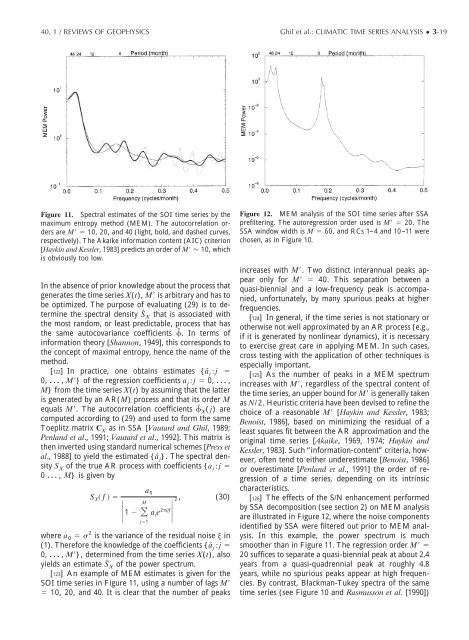advanced spectral methods for climatic time series - Atmospheric ...
advanced spectral methods for climatic time series - Atmospheric ...
advanced spectral methods for climatic time series - Atmospheric ...
Create successful ePaper yourself
Turn your PDF publications into a flip-book with our unique Google optimized e-Paper software.
40, 1 / REVIEWS OF GEOPHYSICS Ghil et al.: CLIMATIC TIME SERIES ANALYSIS ● 3-19<br />
Figure 11. Spectral estimates of the SOI <strong>time</strong> <strong>series</strong> by the<br />
maximum entropy method (MEM). The autocorrelation orders<br />
are M 10, 20, and 40 (light, bold, and dashed curves,<br />
respectively). The Akaike in<strong>for</strong>mation content (AIC) criterion<br />
[Haykin and Kessler, 1983] predicts an order of M 10, which<br />
is obviously too low.<br />
In the absence of prior knowledge about the process that<br />
generates the <strong>time</strong> <strong>series</strong> X(t), M is arbitrary and has to<br />
be optimized. The purpose of evaluating (29) is to determine<br />
the <strong>spectral</strong> density Sˆ X that is associated with<br />
the most random, or least predictable, process that has<br />
the same autocovariance coefficients ˆ. In terms of<br />
in<strong>for</strong>mation theory [Shannon, 1949], this corresponds to<br />
the concept of maximal entropy, hence the name of the<br />
method.<br />
[122] In practice, one obtains estimates {â jj <br />
0, , M} of the regression coefficients a jj 0, ,<br />
M} from the <strong>time</strong> <strong>series</strong> X(t) by assuming that the latter<br />
is generated by an AR(M) process and that its order M<br />
equals M. The autocorrelation coefficients ˆ X( j) are<br />
computed according to (29) and used to <strong>for</strong>m the same<br />
Toeplitz matrix C X as in SSA [Vautard and Ghil, 1989;<br />
Penland et al., 1991; Vautard et al., 1992]. This matrix is<br />
then inverted using standard numerical schemes [Press et<br />
al., 1988] to yield the estimated {â j}. The <strong>spectral</strong> density<br />
S X of the true AR process with coefficients {a jj <br />
0 , M} is given by<br />
S X f <br />
M<br />
1 j1<br />
a 0<br />
aje 2ijf<br />
2 , (30)<br />
where a 0 2 is the variance of the residual noise in<br />
(1). There<strong>for</strong>e the knowledge of the coefficients {â jj <br />
0, , M}, determined from the <strong>time</strong> <strong>series</strong> X(t), also<br />
yields an estimate Sˆ X of the power spectrum.<br />
[123] An example of MEM estimates is given <strong>for</strong> the<br />
SOI <strong>time</strong> <strong>series</strong> in Figure 11, using a number of lags M<br />
10, 20, and 40. It is clear that the number of peaks<br />
Figure 12. MEM analysis of the SOI <strong>time</strong> <strong>series</strong> after SSA<br />
prefiltering. The autoregression order used is M 20. The<br />
SSA window width is M 60, and RCs 1–4 and 10–11 were<br />
chosen, as in Figure 10.<br />
increases with M. Two distinct interannual peaks appear<br />
only <strong>for</strong> M 40. This separation between a<br />
quasi-biennial and a low-frequency peak is accompanied,<br />
un<strong>for</strong>tunately, by many spurious peaks at higher<br />
frequencies.<br />
[124] In general, if the <strong>time</strong> <strong>series</strong> is not stationary or<br />
otherwise not well approximated by an AR process (e.g.,<br />
if it is generated by nonlinear dynamics), it is necessary<br />
to exercise great care in applying MEM. In such cases,<br />
cross testing with the application of other techniques is<br />
especially important.<br />
[125] As the number of peaks in a MEM spectrum<br />
increases with M, regardless of the <strong>spectral</strong> content of<br />
the <strong>time</strong> <strong>series</strong>, an upper bound <strong>for</strong> M is generally taken<br />
as N/ 2. Heuristic criteria have been devised to refine the<br />
choice of a reasonable M [Haykin and Kessler, 1983;<br />
Benoist, 1986], based on minimizing the residual of a<br />
least squares fit between the AR approximation and the<br />
original <strong>time</strong> <strong>series</strong> [Akaike, 1969, 1974; Haykin and<br />
Kessler, 1983]. Such “in<strong>for</strong>mation-content” criteria, however,<br />
often tend to either underestimate [Benoist, 1986]<br />
or overestimate [Penland et al., 1991] the order of regression<br />
of a <strong>time</strong> <strong>series</strong>, depending on its intrinsic<br />
characteristics.<br />
[126] The effects of the S/N enhancement per<strong>for</strong>med<br />
by SSA decomposition (see section 2) on MEM analysis<br />
are illustrated in Figure 12, where the noise components<br />
identified by SSA were filtered out prior to MEM analysis.<br />
In this example, the power spectrum is much<br />
smoother than in Figure 11. The regression order M <br />
20 suffices to separate a quasi-biennial peak at about 2.4<br />
years from a quasi-quadrennial peak at roughly 4.8<br />
years, while no spurious peaks appear at high frequencies.<br />
By contrast, Blackman-Tukey spectra of the same<br />
<strong>time</strong> <strong>series</strong> (see Figure 10 and Rasmusson et al. [1990])






